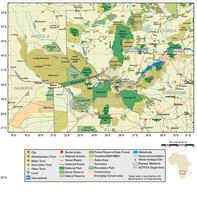
1. Ai-Ais/Richtersveld (SA, Namibia) 2. Kgalagadi (SA, Botswana) 3. Limpopo-Shashe (Botswana, SA, Zimbabwe) 4. Great Limpopo (SA, Zimbabwe, Mozambique) 5. Lubombo (Mozambique, SA, Swaziland) 6. Maloti-Drakensberg (Lesotho, SA) 7. Iona-Skeleton Coast (Angola, Namibia) 8. Liuwa Plain-Kameia (Zambia, Angola) 9. Kavango-Zambezi (Angola, Botswana, Namibia,Zambia, Zimbabwe 10. Lower Zambezi-Mana Pools (Zambia, Zimbabwe) 11. Malawi-Zambia (Malawi, Zambia) 12. Niassa-Selous (Mozambique, Tanzania) 13. Mnazi Bay-Quirimbas (Tanzania, Mozambique) 14. Chimanimani (Mozambique, Zimbabwe)
The Victoria Falls are a key part of what will one day be the largest conservation area in the world, the Kavango-Zambezi Transfrontier Park, a wildlife area covering 287?132km2, involving 5 countries (Zimbabwe, Zambia, Angola, Namibia and Botswana) and 36 game reserves and other protected areas
The Kaza Transfrontier Park, as it is known, will be the size of Italy, and will be a remarkable reclamation, reversing the trend towards the fragmentation of natural habitats.
Pioneered by the Peace Parks Foundation, the brainchild of the South African entrepreneur and conservationist, the late Anton Rupert the Transfrontier Park is a bold attempt to harmonise the conflicting needs of humans and wild animals.
Although still in its embryonic state, Kaza will stretch from the Okavanga Swamps to Mana Pools, and incorporate Hwange and Kafue National Parks along with Angola's fledgling Luiana National Park.
It will host the biggest concentration of elephants in the world and will be a sanctuary for several endangered species such as the cheetah, the African wild dog and the wattled crane.
Brett Hilton-Barber and Lee R. Berger. Copyright © 2010 Prime Origins.
 The Victoria Falls have been billed as the greatest falling curtain of water on the planet, making it one of the seven natural wonders of th...
The Victoria Falls have been billed as the greatest falling curtain of water on the planet, making it one of the seven natural wonders of th...